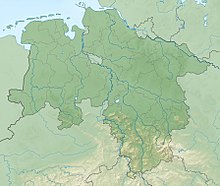Schwingetal (landscape protection area)
Coordinates: 53 ° 34 ′ 11 ″ N , 9 ° 26 ′ 13 ″ E
The Schwingetal is a landscape protection area in the Lower Saxony city of Stade and the communities of Fredenbeck and Kutenholz in the joint community of Fredenbeck and the community of Heinbockel in the joint community of Oldendorf-Himmelpforten in the district of Stade .
The landscape protection area with the sign LSG STD 025 is around 1,502 hectares in size. Most of it is part of the 1,961 hectare FFH area of the same name, which was designated in 2004 . In many cases it borders on the "Schwinge und Sebentäler" nature reserve. In the northeast it borders on the "Schwingewiesen" nature reserve. To the south of Stade, the landscape protection area borders on the nature reserves “ Steinbeck ”, “ Deinster Mühlenbach ” and “ Fredenbecker Mühlenbach ”. In the west, the “ Schwingetal ” nature reserve , located in the district of Rotenburg (Wümme) , adjoins. The Protected Area Ordinance was passed on December 17, 2012. The responsible lower nature conservation authority is the district of Stade.
The landscape protection area extends along the Schwinge from Stade to the border of the district of Stade with the district of Rotenburg (Wümme) between Stade and Bremervörde . It includes the meandering course of the swing arm and parts of the valley with the rocker flowing tributary streams and parts of the adjoining valley slopes. The swing is accompanied in parts by trees, tall herbaceous meadows and vineyards . It is characterized by flooding aquatic vegetation and a changing bed with sandy and gravelly sections. Laichweed and frog-bite communities settle in still waters such as the oxbow lakes south of federal highway 73 .
Large parts of the landscape protection area are occupied by grassland of varying intensity of use and degrees of moisture. In between there are unused or only extensively used areas. Fen areas are criss-crossed by numerous ditches . The grassland areas are characterized in part by tall herbaceous vegetation, sour grass , rushes and herbaceous beds as well as reeds . Small floodplain and bog forests are interspersed in the grassland areas . The alluvial and moor forests are primarily formed by alder, ash and birch. Old beech and oak-hornbeam forests grow in places along the slopes of the valley . On dry inland dunes are places sand heaths with heather and gorse and neglected grassland with silver grass and bentgrass. In places in the landscape protection area there are also damp heaths with bell heather . The biotopes in the landscape protection area are partially protected as legally protected biotopes in accordance with Section 30 of the Federal Nature Conservation Act, independently of the Protected Area Ordinance.
The protected landscape area is the habitat of otters , river and brook lampreys and potentially salmon . Parts of the grassland areas offer various meadow birds a suitable habitat.
The landscape protection area is crossed in Stade by the Niederelbebahn railway line and the federal highway 73. Furthermore, several paths run through the landscape protection area here. Upstream, the protected area is only crossed by district road 1 between Schwinge and Fredenbeck , district road 2 running from Mulsum to federal road 74 and two public roads north of Mulsum. Another road crosses the landscape protection area in the area of Heidbeck in the south of Stade. In the area of the Heidbeck, the landscape protection area is interrupted by the residential development of the Barge district of Stad . In the vicinity of Stade is the Schwedenschanze , an early medieval hill fort in the nature reserve.
The landscape protection area replaces parts of the former 3,500 hectare landscape protection area “Schwinge und Sebentäler”, which stretched along the Schwinge, as well as most of the previously 42 hectare landscape protection area “Schwingewiesen” in the city of Stade, north of the embankment of the Niederelbebahn. The area north of the embankment in particular is of great importance as an urban recreational area , but other parts of the lowland are also used for local recreation.
Large parts of the Schwingetal are to be designated as the Schwinge floodplain .
Web links
- Landscape protection area "Schwingetal" in the database of the Lower Saxony State Office for Water Management, Coastal and Nature Conservation (NLWKN)
- Landscape protection area "Schwingetal" , district of Stade
Individual evidence
- ↑ a b c d Schwingetal , profiles of the Natura 2000 areas, Federal Agency for Nature Conservation . Retrieved September 25, 2019.
- ^ Marshes, reeds and wet meadows: 770 small biotopes in the Schwingetal , Stade district, February 23, 2016. Accessed January 10, 2017.
- ↑ "Schwinge und Sebentäler" and "Schwingewiesen" , Hanseatic City of Stade. Retrieved January 10, 2017.
- ↑ Schwinge floodplain: Suggestions for the ordinance are currently being evaluated , Stade district, November 7, 2014. Accessed January 10, 2017.


